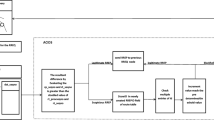Abstract
Mobile ad hoc networks (MANETs) are often prone to variety of attacks like denial of service, impersonation, eavesdropping, camouflaging adversary, blackhole, wormhole, replay, jamming, man in the middle, etc. Among all these attacks camouflaging adversary attack is the attack, launched by an insider and has a devastating effect on network performance. In this paper, we present a cognitive agents (CAs) based security scheme for identifying camouflaging adversaries in MANETs. The proposed scheme uses CAs with observations-belief model to effectively identify camouflaging adversary nodes and the identified nodes will be isolated from the network. The isolation of the camouflaged adversaries enhances the network performance with respect to various performance metrics like bandwidth, throughput, packet drop ratio, reliability, etc.








Similar content being viewed by others

References
Bakshi, A., Sharma, A. K., & Mishra, A. (2013). Significance of mobile AD-HOC networks (MANETS). International Journal of Innovative Technology and Exploring Engineering (IJITEE), 2, 1–5.
Yadav, S., Jain, R., & Faisal, M. (2012). Attacks in MANET. International Journal of Latest Trends in Engineering and Technology (IJLTET), 1(3), 123–126.
Ramachandran, S., & Shanmugan, V. (2011). Impact of sybil and worm-hole attacks in location based geographic multicast routing protocol for wireless sensor networks. International Journal of Computer Science, 7, 973.
Yang, H., Luo, H., Ye, F., Lu, S., & Zhang, L. (2004). Security in mobile ad hoc networks: Challenges and solutions. IEEE Wireless Communications, 11, 38–47.
Rai, A. K., Tewari, R. R., & Upadhyay, S. K. (2009). Different types of attacks on integrated MANET-internet communication. International Journal of Computer Science and Security (IJCSS), 4, 265–274.
Ramachandran, S., & Shanmugam, V. (2012). Performance comparison of routing attacks in MANET and WSN. International Journal of Ad hoc, Sensor Ubiquitous Computing (IJASUC), 3, 41.
Vanamala, C. K., Singhania, P., & Kumar, M. S. (2014). A survey of different lethal attacks ON MANETs. International Journal of Advancements in Research Technology, 3(3).
Shrivastava, S., & Jain, S. (2013). A brief introduction of different type of security attacks found in mobile ad-hoc network. International Journal of Computer Science Engineering Technology (IJCSET), 4(3).
Agarwal, R., & Motwani, M. (2009). Survey of clustering algorithms for MANET. International Journal on Computer Science and Engineering. 1(2), 98–104.
Swapna, G., & Srivatsav, R. P. (2012). Securing web applications by analyzing the logs of the database server or web server. International Journal of Engineering Research and Applications (IJERA), 2(6), 432–435.
Gaines, B. L., & Ramkumar, M. (2008). A framework for dual-agent MANET routing protocols. In IEEE global telecommunications conference-IEEE GLOBECOM.
Mandal, J. K., & Hassan, K. L. (2013). A novel technique to detect intrusion in MANET. International Journal of Network Security its Applications (IJNSA), 5, 179.
Pongaliur, K., Xiao, L., & Liu, A. X. (2009). CENDA: Camouflage event based malicious node detection architecture. In IEEE 6th international conference on mobile ad hoc and sensor systems.
Goyal, P., Parmar, V., & Rishi, R. (2011). MANET: Vulnerabilities, challenges, attacks, application. IJCEM International Journal of Computational Engineering Management, 11, 32–37.
Nadher M. A, Hassan, S., & Kadhum, M. M. (2011). Mobile ad hoc networks under wormhole attack: A simulation study. In Proceedings of the 3rd international conference on computing and informatics.
Roy, D. B., & Chaki, R. (2011). MADSN: Mobile agent based detection of selfish node in MANET. International Journal of Wireless Mobile Networks (IJWMN), 3, 225–235.
Jain, Y. K., & Ahirwar, R. K. (2012). Secure mobile agent based IDS for MANET. International Journal of Computer Science and Information Technologies, 3, 4798–4805.
Kumar, R., & Lokesh, S. (2015). Fast and secure transmission of information among groups using a key management scheme. International Journal of Computer Science and Mobile Computing, 4(11), 40–47.
Meyer, R. & Cid, C. (2008). Detecting attacks on web applications from log files. SANS Institute InfoSec Reading Room.
Ramesh, K., & Somasundaram, K. (2011). A comparative study of cluster-head selection algorithms in wireless sensor networks. International Journal of Computer Science Engineering Survey (IJCSES), 2(4). https://doi.org/10.5121/ijcses.2011.2411.153.
Kumar, P. M., & Gandhi, U. D. (2017). A novel three-tier Internet of Things architecture with machine learning algorithm for early detection of heart diseases. Computers & Electrical Engineering, 65, 222–235. https://doi.org/10.1016/j.compeleceng.2017.09.001.
Varatharajan, R., Manogaran, G., & Priyan, M. K. (2017). A big data classification approach using LDA with an enhanced SVM method for ECG signals in cloud computing. Multimedia Tools and Applications. https://doi.org/10.1007/s11042-017-5318-1.
Manogaran, G., Varatharajan, R., Lopez, D., Kumar, P. M., Sundarasekar, R., & Thota, C. (2017). A new architecture of Internet of Things and big data ecosystem for secured smart healthcare monitoring and alerting system. Future Generation Computer Systems, 80(5), 1–10. https://doi.org/10.1016/j.future.2017.10.045.
Kumar, P. M., Gandhi, U., Varatharajan, R., Manogaran, G., Jidhesh, R., & Vadivel, T. (2017). Intelligent face recognition and navigation system using neural learning for smart security in Internet of Things. Cluster Computing. https://doi.org/10.1007/s10586-017-1323-4.
Kumar, P. M., & Gandhi, U. D. (2017). Enhanced DTLS with CoAP-based authentication scheme for the Internet of Things in healthcare application. The Journal of Supercomputing. https://doi.org/10.1007/s11227-017-2169-5.
Manogaran, G., Varatharajan, R., & Priyan, M. K. (2017). Hybrid recommendation system for heart disease diagnosis based on multiple kernel learning with adaptive neuro-fuzzy inference system. Multimedia Tools and Applications. https://doi.org/10.1007/s11042-017-5515-y.
Author information
Authors and Affiliations
Corresponding author
Rights and permissions
About this article
Cite this article
Kumar, R., Lokesh, S. & Ramya Devi, M. Identifying Camouflaging Adversary in MANET Using Cognitive Agents. Wireless Pers Commun 102, 3427–3441 (2018). https://doi.org/10.1007/s11277-018-5378-1
Published:
Issue Date:
DOI: https://doi.org/10.1007/s11277-018-5378-1



